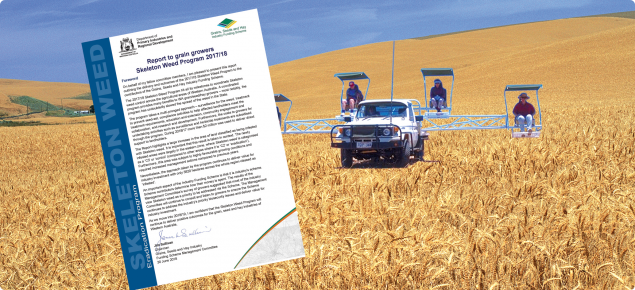Foreword
On behalf of my fellow committee members, I am pleased to present this report outlining the delivery and outcomes of the 2017/18 Skeleton Weed Program to the contributors of the Grains, Seeds and Hay Industry Funding Scheme.
The 2017/18 Skeleton Weed Program hit all its milestones to coordinate Skeleton weed control across the agricultural areas of Western Australia. A coordinated program provides many benefits to WA grain/seed/hay growers – most notably, the program has undoubtedly slowed the spread of the weed in the State.
The program takes a multi-pronged approach – surveillance for the weed, treatment to prevent seed-set, compliance activities to help affected landholders meet the treatment requirements, education and extension, community engagement and collaboration, and research and development. Furthermore, the costs to growers for undertaking activities such as surveillance and herbicide treatments are subsidised through the program. During 2018/17 more than $2 million was used to deliver direct support to landholders.
The Report highlights a large increase in the area of land classified as being infested with Skeleton weed. It is important that this result is taken in context. The newly infested areas were largely in the eastern zone, where Skeleton weed is categorised as a ‘C3’ or ‘control’ (compared to other areas where it is ‘C2’ or ‘eradication’). Furthermore, this area was subject to highly favourable growing conditions and required increased management actions compared to previous years.
Nevertheless, the approach taken by the program continues to deliver value for industry investment with only 3820 hectares across the whole region classed as ‘infested’.
An important aspect of the Industry Funding Scheme is that it is industry’s scheme. Scheme contributors determine how their money is spent. The results of the Management Committee’s survey of growers suggested that most of the industry view Skeleton weed as a priority to be addressed via the Scheme. The Management Committee will continue to consult and listen to growers to ensure the Scheme continues to address the industry’s priority biosecurity issues and deliver value for industry investment.
As we move into 2018/19, I am confident that the Skeleton Weed Program will continue to deliver positive outcomes for the grain, seed and hay industries of Western Australia.
Jim Sullivan
Chairman
Grains, Seeds and Hay Industry
Funding Scheme Management Committee
30 June 2018

